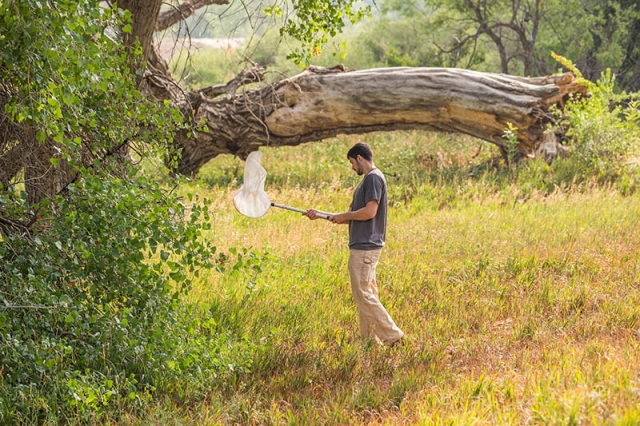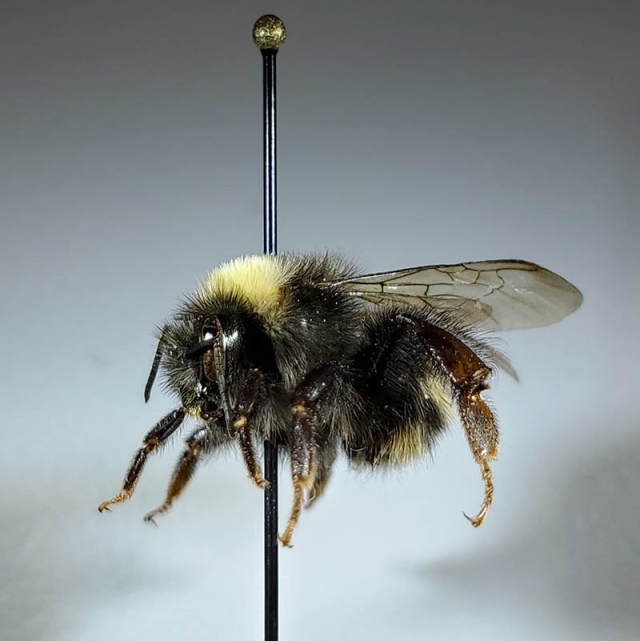From the Vault: A Rare, Exciting Find on the High Line Canal
It was October of 2021, nearly two years after I had finished my master’s degree with Denver Botanic Gardens, when I got an email that made my jaw drop like a ton of bricks. It was from Virginia Scott, the collections manager of entomology at the University of Colorado and one of the state’s foremost experts on native bees. She had been reexamining the hundreds of specimens I collected along the High Line Canal in 2018 as I prepared my research for publication. And there in her notes was something spectacular: Specimen #LC2711: B. occidentalis.
Bombus occidentalis, or the western bumble bee, was once very common in the western United States, but since 1998 has experienced dramatic population declines and is now believed to only exist in small parts of its historical range. To my knowledge, this species had not been collected in Colorado since 2011, although folks have reported observing it.

Liam in 2018 collecting specimens along the High Line Canal.
Bombus occidentalis is a bumblebee, and like most bumblebees, highly social. They form colonies anywhere from a hundred individuals to over one thousand individuals (depending on the species and environmental conditions). And because most bumblebee species are generalists (as opposed to specialists), they are important pollinators of wild plants and cultivated crops in all ecosystems. So why has this species seen such dramatic declines over recent decades? In addition to habitat loss and fragmentation, it is thought that diseases introduced by commercially raised bumblebees is a primary cause. Historically, B. occidentalis and B. impatiens (the common eastern bumblebee) were raised commercially for pollination of greenhouse crops like tomatoes across the U.S. and Europe. Within these rearing facilities, a disease that impacts European bumblebees potentially spread through the commercially raised B. occidentalis populations and then onto wild populations. Colonies would have been exceptionally vulnerable to this novel disease, lacking any natural defenses needed to stave off large scale loss.
You may be thinking, “Don’t you feel terrible for killing one of these rare bees?” Yes, at first, I did. But then I remembered that by collecting and making the bee a specimen in a museum, I provided vouchered proof that this species can and does still occur right in the middle of our densely populated city. I mentioned observations earlier, however these often are not as reliable of a resource when it comes to properly identifying a species. Had I not collected this bee, I never would have been able to reliably say this species is using the High Line Canal as a refuge. Which leaves me with this bit of optimism: There is still hope for bumblebees (and bees in general), including Bombus occidentalis. Many scientists agree that urban areas – including yards, green spaces and natural areas – can have a big impact on bumblebee and general bee conservation. We have the power to create, conserve and restore habitats, so that biodiversity cannot just survive, but thrive alongside our everyday lives.
If you would like to learn more about what you can do to benefit bumblebees and their habitats, read this report from the Xerces Society.

The voucher specimen of Bombus occidentalis collected in 2018, housed in Denver Botanic Gardens' Collection of Arthropods.
Inspired by the fantastic stories of collections highlighted in the 2020 exhibition From the Vault: Wonders and Oddities from the Gardens' Collections, staff working with art, library and natural history collections share wonders and oddities from the collections online. Each entry in this blog series will feature a staff-favorite object. Enjoy these peeks into our storage vaults to learn more about our varied collections.
This article was written by Liam Cullinane, former graduate student with Denver Botanic Gardens, who graduated with a master's degree in biology from the University of Colorado in 2020.
Add new comment